Prime Day has been an unstoppable force in ecommerce for years. Even the dark cloud of inflation didn’t stop Amazon from having its biggest Prime Day ever in 2022, when the two-day period reportedly drove $12 billion in sales, including $3 billion generated from small businesses.
While inflation and tighter consumer budgets are still in play in 2023, brands can expect the good times to roll during this year’s 48-hour summer sales event on July 11-12th. After all, Prime Day is still a critical part of Amazon’s larger plan, helping the ecommerce giant drive new Prime membership sign-ups, boost sales in a tough economy, and maintain a substantial competitive edge over a growing list of major retail media competitors like Walmart.
But the benefits of Prime Day aren’t Amazon’s alone. If you want to make the most of this opportunity to juice your revenue, your brand needs to put the right strategy in place before it’s too late.
Love Amazon lightning deals, but they aren’t the only option
Amazon lightning deals are even more prominent this year as a preferred deal type, as consumers showed a strong preference for those offers on the first day of Prime Day last year. Lightning deals play a crucial role in increasing product exposure, boosting conversions, and attracting the attention of eager consumers ready to spend.
It’s likely too late to create new lightning deals now if you haven’t already, but lightning deals don’t aren’t the only way to get on the radar of new potential customers. You can look to capture customer interest this Prime Day with options including:
- Prime Exclusive Discounts: These promotions offer a price discount available only to Prime members, and have several requirements to launch. Buyers will see a savings summary in search results and on the product detail pages, which have included the “Prime Exclusive Deal” badge in past years.
- Coupons: Coupon promotions may be effective when paired with healthy budgets for non-brand and customer acquisition.
- Best Deals: These promotions are often featured as a price discount on the Amazon deals page and can be used to drive traffic to a set of products. Although these are invite-only, check to see if your brand has any that overlap with Prime Day dates.
- Promo Codes: Each promo code has a unique page that you can market yourself, and you can share your promo code with Amazon Associates and Influencers, which may help drive more traffic from social channels.
- Price Discount: Discounts can help increase demand and have the potential to be showcased as a featured offer. You also have the option to allow merchandising by site merchandisers, the Amazon email team, and the Amazon Deals team.
- Sale Price: While this isn’t technically a structured deal or promotion, you can set a “Sale Price” at no cost to help highlight a discount on your listings.
Other platforms are capitalizing on the high purchase intent driven by Amazon Prime Day
Ever since Prime Day became an annual phenomenon, competitors have jumped on the shopping bonanza driven by Amazon’s big sale spotlight to take advantage of consumers looking to cash in on heavily discounted items. While Amazon will undoubtedly still lay claim to the vast majority of Prime Day sales, you shouldn’t ignore other retail media opportunities. Experts suspect that Amazon has started waiting longer to drop the official Amazon Prime dates to give notable competitors like Walmart and Target less time to activate against it.
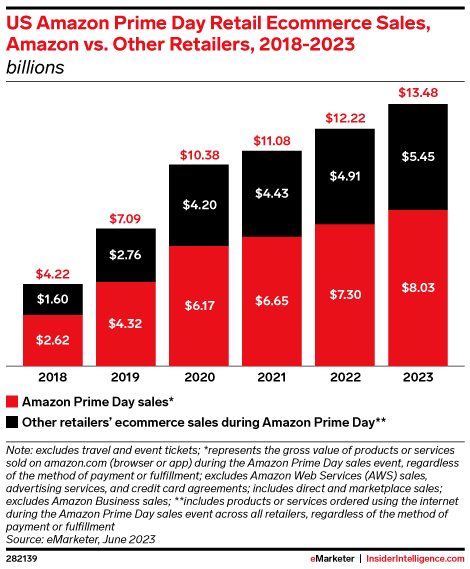
Source: eMarketer
To some degree, Amazon has become a victim of their own success as competitors plan their own sales events to coincide with Prime Day. This year, Walmart is launching “Walmart+ Week” on July 10-13, and Target announced “Target Circle Week” for the week of July 9-15. People are still going to Amazon first on Prime Day, but if Amazon doesn’t have what they’re looking for, they’re going to look for a deal somewhere else.
Since consumers are willing to make the leap to other platforms on Prime Day, your brand should be, too. Take a look at your budgeting plans for other marketplaces and make sure you’re accounting for the increased traffic and set your budget caps and bids accordingly. On non-Amazon platforms, expect Prime Day traffic to be two to three times more than average. Keep your budgets fluid to make performance-based adjustments after day one, and put a contingency plan in place to shift spend if products sell out on particular marketplaces.
Amazon Marketing Cloud Audiences feature can help you retarget potential customers and increase conversions
With the new Amazon Marketing Cloud Audiences feature, businesses can create audiences based on customers who added items to their cart but did not complete the purchase in the past 90 days. This gives advertisers a whole new audience to play with this year and gives you the opportunity to retarget these potential customers with deals and promotions during and after Prime Day, leading to increased conversions.
- Awareness: Audiences who have engaged with Streaming TV ads but not yet exposed to display ads, or audiences who are over-exposed to ads across media channels (used for audience exclusion)
- Consideration: Audiences who viewed the product detail page multiple times after ads exposure, or audiences who added advertised products to their wish list
- Conversion: Audiences who explored certain keywords post-ad exposure, or audiences who added a product to cart but did not complete the purchase
- Loyalty: Audiences who purchased from the brand last year but have no recent engagements, or audiences with high customer long-term value (CLV) based on past purchases
You can use Amazon Marketing Cloud to better understand how Amazon ads can drive value, focusing on full-funnel marketing campaigns rather than just last-click attribution. As you’re planning out your Prime Day strategy, this tool will give you a clearer view of the impact of upper-funnel campaigns as well as their contribution to conversions alongside lower-funnel expenditures. You can leverage those insights to optimize your campaigns for better efficiency and cost-effectiveness, which can help you if you need to defend your budget later in the year.
Speaking of data and insights…
Use Prime Day data to get insights into ecommerce behavior ahead of the holidays
Prime Day doesn’t end when the last sales are over. If Prime Day goes well for your brand, you’ll have collected lots of useful new data and a list of deal-hunting customers you’ll want to leverage long after July 12th. Don’t miss the opportunity to learn from the data you’ve collected and inject those insights into your strategy this holiday shopping season (and in the likely case there is another Fall Prime event like last year.)
The new customers who purchased products during Prime Day are still likely to be interested in future deals from your brand, especially over the holidays just a few months from now. By staying on their radar, you’ll have an opportunity to capitalize on their previous interest in your brand for big wins later in the year. Keep track of them by creating custom audiences and reaching out to them during subsequent events, reminding them of their past purchases or consideration and offering relevant promotions.
You should continuously engage with these customers after Prime Day with targeted campaigns leading up to the biggest shopping days of the holiday season. Tailored messages will help you establish a stronger connection and keep your brand top of mind. Highlighting the perfect gift angle for products can also tap into the potential for repeat purchases, increasing customer loyalty and overall sales.
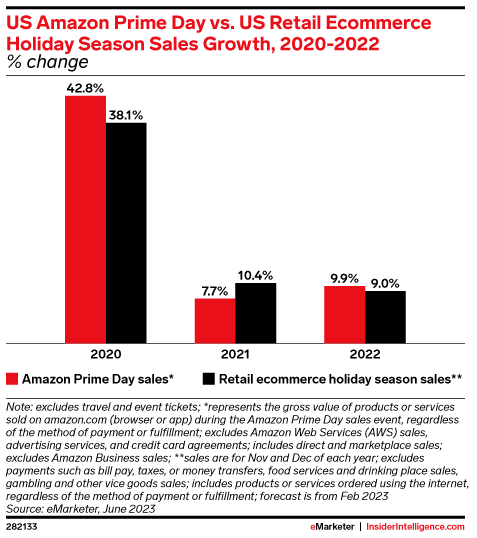
Source: eMarketer
It’s important to keep people who’ve already bought a product in mind. Loyal customers are a valuable resource for potential cross-sell opportunities. Analyze the products they have already purchased and determine which complementary products could enhance their experience or meet their needs. By offering personalized recommendations to these customers, you can drive additional conversions and increase lifetime value.
You should also be sure to hit up your Prime Day customers when you have deals available. You already know that they are more inclined to buy during deal events, so they may be more receptive to offers and promotions than other customers. Use this opportunity to test different upselling strategies and determine how to best encourage these customers to make additional purchases. Understanding their deal sensitivity can unlock new avenues for revenue growth.
With more opportunities for businesses to engage customers and drive sales than ever, Prime Day continues to hold the throne as one of the biggest ecommerce events of the year for participating retailers. Your brand should take advantage of the lead-up while you still can. With careful planning, effective remarketing, and a comprehensive funnel approach, you can use Prime Day as a jumping off point for future success this summer and beyond.




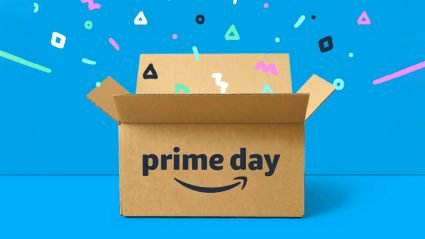

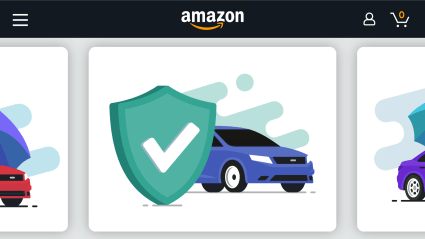
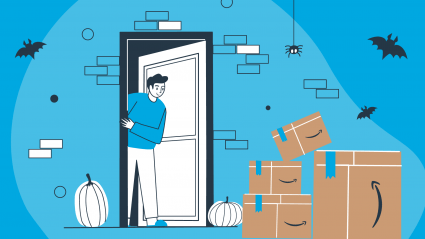
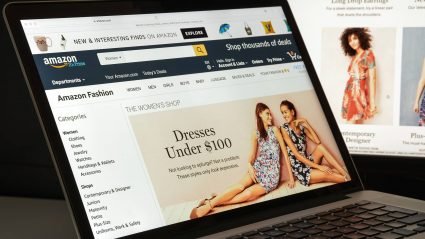
Responses